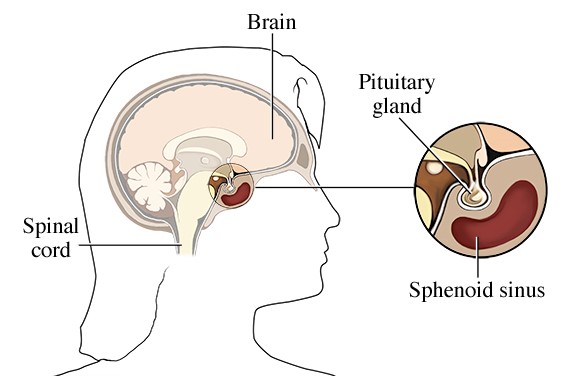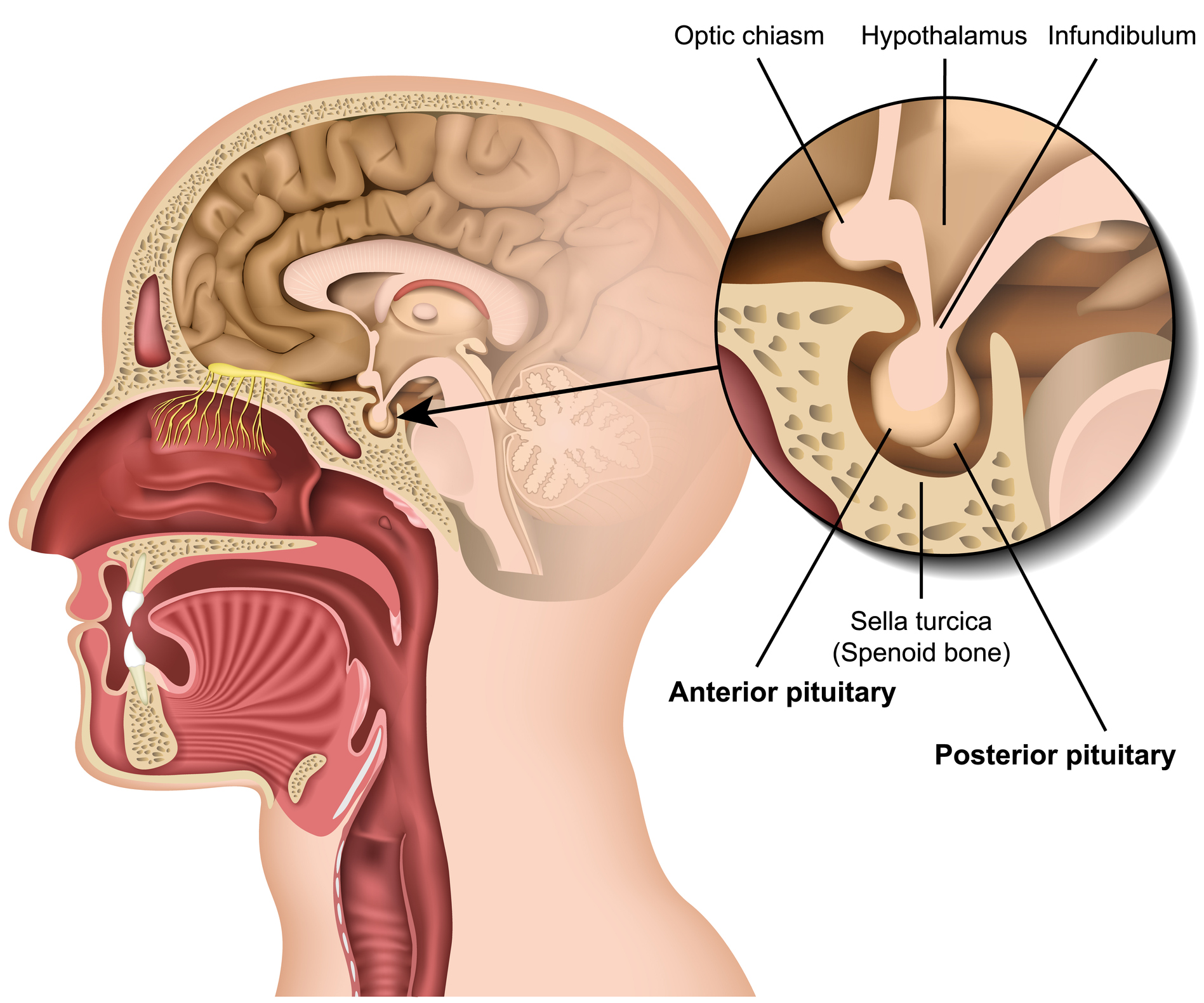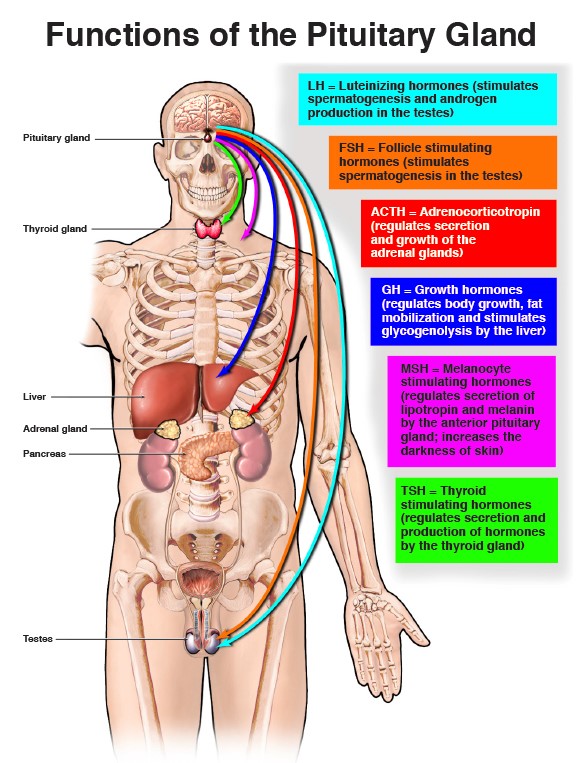Understanding Pituitary Disorders
Pituitary disorders can cause a range of symptoms. They can also be challenging to diagnose. They share these traits:
- The pituitary gland may raise or lower one or more hormones.
- A hormone imbalance can cause physical or mood changes. At the same time, pituitary disorders often develop slowly. It may take a long time until you notice symptoms.
- Symptoms of pituitary disorders are similar to those of other diseases. Many people are misdiagnosed or go undiagnosed.
The pituitary gland

Medical Illustration Copyright © 2020 Nucleus Medical Media. All rights reserved.
What are pituitary disorders?
What does the pituitary gland do?
First, it helps to understand the pituitary gland.
The “master gland”: The pituitary gland is about the size of a pea. It sits at the base of the brain, roughly behind the bridge of your nose. It’s often called the “master gland” because it produces several hormones and controls other glands, such as the thyroid gland and the adrenal glands.

Part of the endocrine system: The pituitary gland is part of the endocrine system, the body’s hormone system. Hormones are natural chemicals, circulated mostly in the bloodstream, that guide everything from growth to fertility.
Anatomy: The pituitary has two parts, an anterior lobe and a posterior lobe. Each lobe releases different hormones. The pituitary gland is attached to the bottom of the hypothalamus, a part of the brain that connects the nervous system and endocrine system. The hypothalamus releases hormones, and it signals the pituitary gland to release hormones.
For patients
- Referral: To become a patient, please ask your doctor for a referral.
- Questions: For questions or follow-up appointments, call 503-494-4314.
Location
Parking is free for patients and their visitors.
OHSU Pituitary Center
Center for Health & Healing Building 1
3303 S. Bond Ave.
Portland, OR 97239
Map and directions
Refer a patient
- Refer your patient to OHSU.
- Call 503-494-4567 to seek provider-to-provider advice.
- See more pituitary information for health care professionals.
- OHSU Provider’s Guide to Pituitary Disorders
Pituitary disorders
Pituitary disorders occur when the pituitary gland makes too much or too little of a particular hormone. Most often, these disorders are caused by a pituitary tumor.
Most pituitary tumors are noncancerous (benign). But when a tumor grows on or near the pituitary gland, the tumor can:
- Change hormone production, leading to symptoms such as weight gain, stunted or excessive growth, high blood pressure, low sex drive or mood changes.
- Press against the pituitary gland, optic nerves or brain tissue, causing vision problems or headaches.
Learn more about diagnosis and treatment for pituitary disorders at the OHSU Pituitary Center.
Hormones the pituitary gland makes
The pituitary gland produces many hormones that regulate bodily functions:

- Adrenocorticotropic hormone: ACTH causes the adrenal glands to produce cortisol. This hormone helps your body regulate blood pressure, respond to infections, and control sugar, fat and protein.
- Follicle-stimulating hormone: FSH affects reproduction, helping to release eggs in women and to make sperm in men.
- Growth hormone: GH controls growth in childhood and adolescence. In adults, it maintains body structure and energy production (metabolism).
- Luteinizing hormone: LH, along with FSH, helps with reproduction.
- Prolactin: This hormone is involved in breast milk production (lactation).
- Thyroid-stimulating hormone: TSH controls the amount of hormones produced by the thyroid gland. These hormones affect metabolism and growth.
- Antidiuretic hormone: ADH helps your kidneys manage the amount of water in your body.
- Oxytocin: This hormone helps control reproductive system functions, including birth and lactation.
Medical Illustration Copyright © 2020 Nucleus Medical Media. All rights reserved.
Who gets pituitary disorders?
Pituitary disorders can affect people of any age or sex.
Inherited disorders: If you have a family history of certain genetic conditions, you have a higher chance of developing a pituitary disorder. Genetic conditions include:
- Multiple endocrine neoplasia, type I (MEN I)
- Familial isolated pituitary adenoma (FIPA)
Consider talking with your doctor about genetic testing. The OHSU Neuro Genetics Clinic can advise you about your level of risk as well as testing options.
Rare disorders: Many pituitary disorders are uncommon. At the same time, estimates for the number of people with acromegaly or Cushing disease/syndrome may be too low. Estimates include:
- About six to 11 people in 100,000 live with acromegaly, a disorder caused by too much growth hormone.
- About 10 to 15 people per million are diagnosed with Cushing disease/syndrome, caused by too much cortisol, each year in the U.S.
- Craniopharyngiomas, noncancerous pituitary tumors, affect one or two people per million each year in the U.S.
What causes pituitary disorders?
Noncancerous pituitary tumors are the main cause of pituitary disorders. Tumors often cause your body to make too much or too little of a hormone, leading to a disorder such as acromegaly.
Other common causes of pituitary disorders include:
- Head injury
- Bleeding in or near the pituitary gland
- Some medications and cancer treatments
Types of pituitary disorders
Doctors classify each pituitary tumor based on whether it produces hormones.
- Secretory tumors, also called functioning adenomas, affect hormone production. Some people produce too much of a hormone, called hypersecretion. Others experience hyposecretion, or not having enough of a hormone.
- Nonsecretory tumors, also called nonfunctioning adenomas, do not affect hormone production. However, when they grow too large, they can press on the pituitary gland and other brain structures, causing headaches and vision problems.
Learn more about these pituitary disorders:
Signs and symptoms of pituitary disorders
Specific symptoms often depend on the disorder and hormone affected. A tumor’s location and size play roles, too. Common symptoms include:
- Anxiety or depression
- Diabetes
- Hair loss
- High blood pressure
- Irregular menstrual periods
- Unexpected breast milk production
- Low energy or low sex drive
- Stunted growth or unusual growth spurts
- Unexplained weight gain
- Vision changes
Learn more
- Pituitary Disorders, U.S. National Library of Medicine
- Pituitary Gland, Home Health Network
- Pituitary Tumors Information Page, National Institute of Neurological Disorders and Stroke
- Pituitary Tumors: Condition Information, Eunice Kennedy Shriver National Institute of Child Health and Human Development